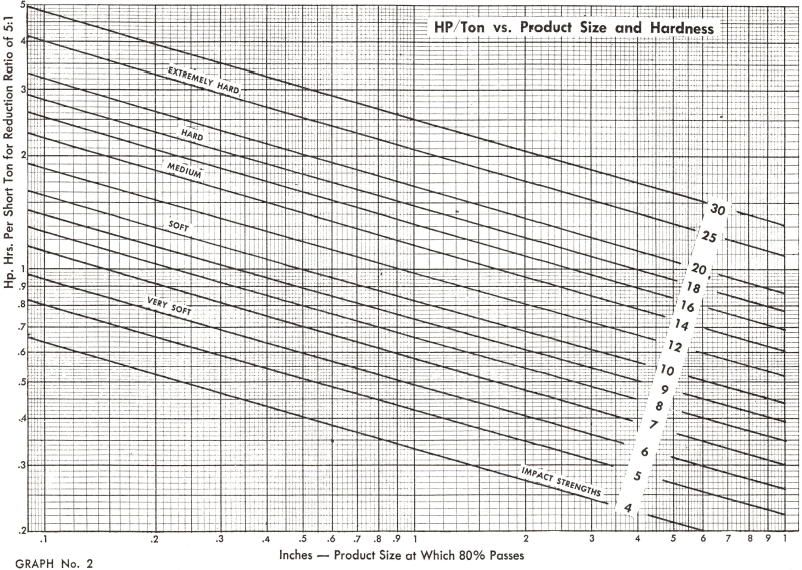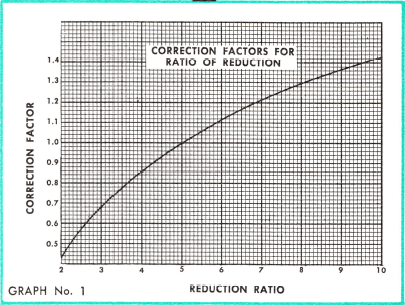Table of Contents
In the cone crusher capacity table, a maximum motor size recommendation is given for any eccentric throw. Only in rare circumstances is this maximum horsepower required; in many installations a motor of only half the rating of the maximum is required.
If there is any doubt regarding the proper motor size, a sample of the material to be crushed should be sent to the Basic Industries Research Laboratory for impact and compression tests, in order that the proper motor size recommendation can be made.

Calculate Crusher MOTOR HORSEPOWER
Crushing horsepower required is dependent on the hardness and toughness of the material, the ratio of reduction, product size, and the specific gravity. The following method of approximating horsepower requirements may be used as a guide to proper motor selection and power cost estimation:
- Determine the feed size as the size, square mesh in inches, through which 80 percent of the fed material will pass.
- Determine the product size as the size, square mesh in inches, through which 80 percent of the product will pass. If screen analysis is not available, use this graph to estimate screen analysis of crusher.
- Calculate ratio of reduction by dividing feed size (1) by product size (2).
- Determine impact strength of material by laboratory tests or estimate by use of tables below.
- From Graph No. 2, find the horsepower hours per short ton at the reduction ratio of 5:1. Locate the product size as determined in step (2) at the bottom of Graph No. 2. Go vertically to the diagonal line representing the toughness (impact strength) of the material, and then horizontally to the proper value of horsepower hours per ton.
- Correct for reduction ratios other than 5:1. The ratio determined in step (3) is found at the bottom of Graph No. 1. Proceed vertically to the curve and then horizontally to the correction factor.
- Correct for the weight of the material, if it weighs other than 100 lb per cu ft, broken, or if the specific gravity is other than 2.65. The factor is 100 divided by the weight per cu ft, or 2.65 divided by the material’s specific gravity. Refer to page 18 for the weights per cu ft, crushed, of some of the more common materials.
- Determine the correction factor for fines in the feed. This factor is 80 minus the percent passing the product size in the feed, all divided by 80.
- The total and corrected horsepower hours required per short ton is the product of hp-hr per ton from step (5) and the correction factors, or the product of steps (5), (6), (7) and (8).
- Multiply the product from step (9) by the tons per hour to obtain the gross hp required.
Cone Crusher Motor Sizing
Hard limestone, having an impact strength of 15, is fed from a secondary crusher set at 3¼-in. open side setting, producing stone having 80 percent minus 3¼-in. The product of the secondary crusher is screened at 5/8-in. The screening results in 5 percent minus 5/8-in. material in the tertiary crusher feed. Eighty tons per hour of this limestone is to be crushed to 100 percent minus 1 3/8-in. square testing sieve in a tertiary crusher. The crusher tentatively selected is an 848 Hydrocone crusher with a 5/8-in. eccentric throw and 5/8-in. close side setting. Product (from Graph No. 1) is 80 percent minus 15/16-in.
CALCULATIONS
- Feed size is 3¼-in.
- Product size is 15/16-in.
- Ratio of reduction is 3¼-in. divided by 15/16-in. or 3.45.
- Impact strength is 15.
- 15/16-in. is found in Graph No. 2. Follow up to line 15, and across to 1.25 hp-hr per ton.
- Using Graph No. 1, the reduction ratio of 3.45 has a correction factor of 0.76.
- Limestone weighs 100 lb per cu ft, broken. No correction factor.
- Correction for fines in the feed is (80.5) divided by (80), or .9375.
- Horsepower hours per ton is (1.25) x (0.76) x (1.00) x (0.9375), or 0.89.
- Gross horsepower is (0.89) x (80), or 71.
The gross horsepower from step (10) is used to select the nearest commercial size electric motor available.
Where conditions prevent the use of electric motors, diesel or gasoline engines may be used. The rated hp of an internal combustion engine must be greater than that of an electric motor to drive the same crusher, because electric motors have excess momentary capacity limited by the pull-out torque and starter capacity. This is not present in internal combustion engines and must be compensated for by the use of a larger engine. The intermittent rated power of the internal combustion engine, which is 90 percent of its maximum rating, should be at least 150 percent of the electric motor rating.
The toughness of a material, or its resistance to crushing, must be determined by an impact test, or approximated by comparison to a known material. A list of impact values which may be used for comparison will be found on here.
The results obtained from the above empirical formula can be used as a guide for the selection of motors for a given crushing operation. The formula can be used with considerable accuracy for operations where the impact strength is the equivalent of, or less than, a hard limestone (impact value 15-18 lb per inch). For materials of increasing impact strength, the formula frequently yields results which are higher than actual tests indicate they should be. Structurally weak veinlets or invisible cracks from explosives may reduce the energy required to break large pieces; if material packs in the crusher, the energy required will be increased. In all applications, it must be remembered that this formula is empirical, and although derived from actual field tests, may give results which vary considerably from the actual.
How to Select the Correct CONE Crusher
SIZING THE CONE CRUSHER
The actual selection of a Hydrocone crusher depends upon the consideration of all the factors outlined above, i.e. feed size, capacity required, product required, and operating conditions. Quite logically, the smallest Hydrocone crusher to do a given job should be selected.
If the crusher is installed as a secondary following a primary crusher, the size must be selected to allow for anticipated wear of the discharge setting of the primary crusher. If a variety of products will be required, provision must be made in the original selection to allow for the closest setting which will be needed.

